B2.1 Use the properties of operations, and the relationships between operations, to solve problems involving whole numbers, decimal numbers, fractions, ratios, rates, and whole number percents, including those requiring multiple steps or multiple operations.
Skill: Using the Properties of Operations
Understanding the properties of operations and the relationships between them allows for more flexible use.
A good sense of operations relies on a good knowledge of the relationships between numbers and between operations.
Understanding the properties of the operations allows one to develop efficient computational strategies; for example, since multiplication is distributive, one can compute \(5 \times 12\) by performing \((5 \times 10 ) + (5 \times 2) \).
In the primary grades, students were able to approach some of these properties intuitively. Students in the junior grades need to understand the properties of the operations presented below and learn to use them in problem solving situations.
Commutative Property
An operation is commutative if its result does not change when the order of its terms is reversed. Addition and multiplication are commutative. For example, the commutative property of addition can be demonstrated as follows: there are 44 apples in one basket and 32 in another. The total number of apples will be the same whether we add the apples in the first basket to the apples in the second basket or whether we do the opposite. Thus, \(44 + \;32\) is equal to \(32 + \;44\). We recognize that if the terms of an addition are switched, the result remains the same.
We can also demonstrate the commutative property of multiplication.
Examples


The two previous arrangements represent the same total quantity, organized in two different ways. Therefore, they illustrate two different situations. For example, \(8 \times 3\) is 8 rows of 3 objects, while \(3 \times 8\) is 3 rows of 8 objects. It is important that students recognize the different representations.
You can also use an everyday example. For example, the teaching staff invites three students who have exactly one brother or sister to represent the children of their family on the board. The total number of children is represented by \(3\; \times \;2\) children, for a total of 6 children (Figure 1).
Then, teachers do the same with two children who have exactly two siblings. The total number of children is represented by 2 children, for a total of 6 children (Figure 2).
Figure 1

Figure 2

The two number sentences, \(3\; \times \;2\; = \;6\) and \(2\; \times \;3\; = \;6\), indicate the same result, even if the order of the factors is reversed. The pupils can then understand that 3 families of 2 children or 2 families of 3 children give a total of 6 children, without the situations being identical.
When using the commutative property of multiplication, we are more interested in the answer, regardless of the situation. For example, even if we are looking for \(12 \times \;2\), we may choose to calculate \(2 \times 12\) if the result is easier to obtain, even if the two expressions do not represent the same situation.
When first learning multiplication, students often perceive multiplication as repeated addition. As they attempt to solve a variety of problems, they may use the commutative property of multiplication to develop a more efficient strategy for calculation. For example, students who use repeated addition would recognize that \(2 \times 12\;( 12 + 12)\) is simpler and less time-consuming to represent and compute than \(12 \times 2\;( 2 + 2 + 2 + 2 + 2 + 2 + 2 + 2 + 2 + 2 + 2 + 2) \).
An array is an excellent visual model for representing the commutative property of multiplication.
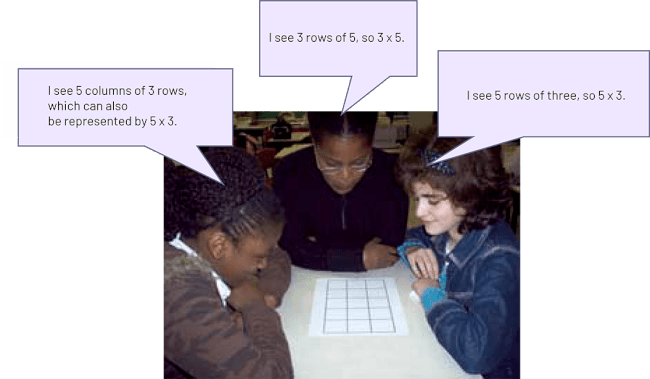
An array can also be used to represent the commutative property of multiplying a whole number by fractions. For example, a cook wants to cook a turkey that weighs 9 kg. Each kilogram takes \(\frac{1}{3}\) of an hour to cook. He must calculate the total number of hours to cook the turkey.
It is possible to represent the number of hours by \(9 \times \;\frac{1}{3}\), for a total of 3 hours (Figure 1).
It is also possible to represent the total number of hours by \(\frac{1}{3} \times \;9\), for a total of 3 hours (Figure 2).
Figure 1

The turkey will cook for 3 hours.
Figure 2
\(\frac{1}{3}\)
\(\frac{1}{3}\)
\(\frac{1}{3}\)
1 hour
\(\frac{1}{3}\)
\(\frac{1}{3}\)
\(\frac{1}{3}\)
1 hour
\(\frac{1}{3}\)
\(\frac{1}{3}\)
\(\frac{1}{3}\)
1 hour
\(\frac{1}{3} \times 9\)
The turkey will cook for 3 hours.
Source: Adapted and translated from Guide d’enseignement efficace des mathématiques de la 4e à la 6e année, Numération et sens du nombre, Fascicule 1, Nombres naturels, p 102-104.
Distributive Property
The distributive property allows a number in a multiplication expression to be decomposed into two or more numbers. For example, one can multiply \(3 \times (5 + 6)\) or \(3.1 \times (5.2 + 6) \) and get the same result as if one had multiplied on each term separately as \((3 \times 5) + (3 \times 6) \) or \((3.1 \times 5.2) + (3.1 \times 6) \). Multiplication is also distributive over subtraction. For example, you can multiply \(3\; \times \;\left( {20\; - \;2} \right)\) or \(3.1\; \times \;\left( {20\; - \;2.5} \right)\) as \(\left( {3\; \times \;20} \right)\; - \;\left( {3\; \times \;2} \right)\) or \(\left( {3.1\; \times \;20} \right)\; - \;\left( {3.1\; \times \;2,5} \right)\).
The following example illustrates how the distributive property can be used to calculate \(6 \times \;8\). In one case, the factor 8 is decomposed into \(5 + \;3\) to make \(6\; \times \;\left( {5\; + \;3} \right)\; = \;\left( {6\; \times \;5} \right)\; + \;\left( {6\; \times \;3} \right)\). In the other case, the factor 6 is decomposed into \(3 + \;3\) to make \(\left( {3\; + \;3} \right)\; \times \;8\; = \;\left( {3\; \times \;8} \right)\; + \;\left( {3\; \times \;8} \right)\).
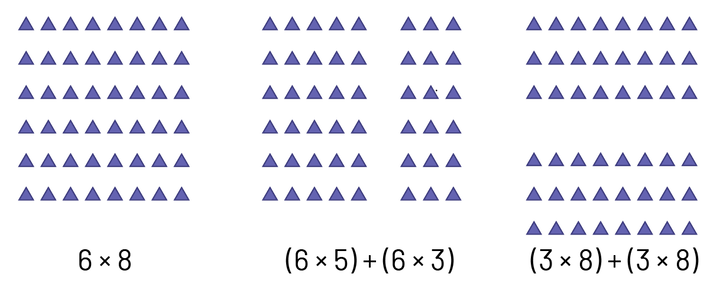
The following is an example of using the distributive property when making a calculation involving decimal numbers, for example \(6.5\; \times \;4\).
In one case, the factor 4 is decomposed into \(2 + 2\) to make \(6.5 \times (2 + 2) = (6.5 \times 2) + (6.5 \times 2)\). In the other case, the factor 6.5 is decomposed into \(6 + 0.5\) to make \((6 + 0.5) \times 4 = (6 \times 4) + (0.5 \times 4)\).

There is an important relationship between the distributive property and the standard North American multiplication algorithm. For example, to calculate \(3\; \times \;15\), the 15 is decomposed into \(\left( {10\; + \;5} \right)\):
\(3\; \times \;\left( {10\; + \;5} \right){\rm{,\;so}}\;\left( {3\; \times \;10} \right)\; + \;\left( {3\; \times \;5} \right)\)

To calculate \(13 \times \;24\), the two factors are decomposed:

Only multiplication is distributive. However, one could recognize that division is partially distributive. For example, to compute \(32 \div 8\), it is possible to decompose the dividend 32 into 16 + 16. The division by 8 is distributed on the addition such that \(\left( {16\; \div \;8} \right)\; + \;\left( {16\; \div \;8} \right)\; = \;2\; + \;2\), which is 4. However, if the divisor is decomposed, the distributive property does not work. For example, \(32\; \div \;8\; \ne \;\left( {32\; \div \;4} \right)\; + \;\left( {32\; \div \;4} \right)\). This is the reason why the distributive property is not a property of division.
Source: translated from Guide d’enseignement efficace des mathématiques de la 4e à la 6e année, Numération et sens du nombre, Fascicule 1, Nombres naturels, p 104-105.
Associative Property
The associative property is a property of addition and multiplication. It allows one to combine the terms of an expression in different ways without changing the value. For example, in the expression \(15\; + \;13\; + \;17\), it is possible to combine 13 and 17 to make \(15\; + \;\left( {13\ ; + \;17} \right)\), which gives \(15\; + \;30\), which is equal to 45. One can also associate 15 and 13 to obtain \(\left( {15\; + \;13} \right)\; + \;17\), which gives \(28\; +\;17\), which is equal to 45.
The associate property also applies to decimal numbers, for example, in the expression \(5 + 0.75 + 0.25\), it is possible to associate 0.75 and 0.25 to obtain \(5 + (0.75 + 0.25)\), which gives 5 + 1, that is to say 6. We can also combine 5 and 0.75 to obtain \((5 + 0.75 ) + 0.25\), which gives 5.75; + 0.25, that is 6.
The associative property can also be applied to addition and multiplication terms involving fractions and percentages, for example 5% + 10% + 20% could be associated as follows \(( 5\% + 10\% ) + 20\% \), which gives \(15\% \; + \;20\% \), or 35%.
It is important to recognize that the associative property of multiplication (for example, \(3\; \times \;2\; \times \;5\; = \;3\; \times \;\left( {2\; \times \; 5} \right)\) or \(3\; \times \;2\; \times \;5\; = \;\left( {3\; \times \;2} \right)\; \times \;5\)] is not easy to understand. Certainly, it can be seen by checking the results of the multiplications, but this does not constitute an understanding. To understand, one can use an extension of the model of a rectangular array made with cubes.
In Figure 1, there are 2 rows of 5 cubes, or \(2\; \times \;5\) cubes. In Figure 2, there are 3 layers each containing \(2\; \times \;5\) cubes. The figure therefore represents \(3\; \times \;\left( {2\; \times \;5} \right)\) cubes.
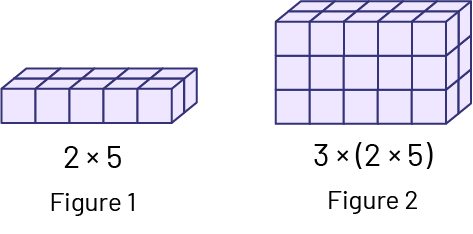
We can also consider Figure 3, which illustrates 3 layers of 2 cubes, or \(3\; \times \;2\) cubes. Figure 4 can then represent \(\left( {3\; \times \;2} \right)\) cubes which appear 5 times, or \(\left( {3\; \times \;2} \right )\; \times \;5\).

So we see that \(3\; \times \;\left( {2\; \times \;5} \right)\) and \(\left( {3\; \times \;2} \right) \; \times \;5\) represents the same amount of cubes (even though each expression represents a different point of view) and each gives the same product as \(3\; \times \;2\; \times \;5\).
With an expression such as \(3\; \times \;\left( {2\; \times \;5} \right)\; = \;?\), some students sometimes attempt to apply the distributive property so that they calculate \( (3 \times \;2) \times (3\; \times \;5) \), which results in \(2 \times \;5\) being multiplied by 9, rather than by 3. In such a case, remind students that the distributive property of multiplication is performed only on addition or subtraction and explain the situation using a concrete or visual (semi-concrete) model.
The associative property does not change the order of numbers in a numerical expression. However, the associative property and the commutative property can be combined to facilitate the evaluation of a numerical expression.
For example, to determine the value of the expression \(2\; \times \;3\; \times \;5\), one can also use the expression \(\left( {2\; \times \;5} \right)\; \times \;3\) as it is usually easier to calculate \(10\; \times \;3\) than to calculate \(6\; \times \;5\). Similarly, to determine the value of the expression \(19\; + \;27\; + \;11\), one can also use \(\left( {19\; + \;11} \right )\; + \;27\), because the 9 and the 1 are complementary and make a ten, which is easier to work with mentally, as \(30\; + \;27\; = \;57 \). It is by experiencing a large number of such activities that students will come to understand and use the different properties effectively.
Decomposing a number into a product of factors, along with the associative property, can also be useful. For example, the number 24 can be represented by \(24\; \times \;1\), \(12\; \times \;2\), \(8\; \times \;3\), \(6\; \times \;4\) or even by \(2\; \times \;4\; \times \;3\) or \(2\; \times \;2\; \times \; 2\;\times\;3\). To determine the value of a numeric expression such as \(24\; \times \;5\), students with good number and operation sense may choose to transform 24 into \(12\; \times \;2\) and use the operations properties as follows:
\(\begin{align}24\; \times \;5\; &= \;12\; \times \;2\; \times \;5\\ &= \; 12\; \times \;\left( {2\; \times \;5} \right)\\ &= \;12\; \times \;10\\ &= \;120\end{align}\)
or
\(\begin{align}24\; \times \;5\; &= \;12\; \times \;2\; \times \;5\\ &= \;\left( {12\; \times \;5} \right)\; \times \;2\\ &= \;60\; \times \;2\\ &= \;120\end{align}\)
Source: translated from Guide d’enseignement efficace des mathématiques de la 4e à la 6e année, Numération et sens du nombre, Fascicule 1, Nombres naturels, p 105-107.
Skill: Using the Order of Operations
The order of operations is in the curriculum in Grade 6, but students in other grades may address these rules informally. In the classroom, it is more important to focus on the meaning of expressions in a problem-solving context than on the ability to evaluate expressions with multiple operations.
The order of operations can occur in a problem-solving context or in operations presented as numerical expressions without context.
Operations in a problem-solving context
To solve a problem involving a series of operations, the order to be followed is dictated by the meaning of the problem.
Example 1
Simon has 3 envelopes containing 5 stamps each and his sister Annabelle has 7 envelopes containing 4 stamps each. They decide to put all their stamps together to form a larger collection. How many stamps are in their joint collection?
To solve this problem logically, students must first determine the number of stamps in Simon's collection (\(3\; \times \;5\; = \;15\)), then the number of stamps in Annabelle's collection (\(7\; \times \;4\; = \;28\)). Then they have to find the total number of stamps in the 2 collections (\(15\; + \;28\; = \;43\)). Here, multiplication takes precedence over addition.
To represent all these operations in a single numerical expression, we could write \(3 \times \;5 + \;7 \times \;4\). However, this expression can be confusing, so using brackets is important to specify the order of operations as follows:
\(\begin{align}\left( {3\; \times \;5} \right)\; + \;\left( {7\; \times \;4} \right)\; &= 15\; + \;28\ = 43\end{align}\)
So, the common collection contains 43 stamps.
In the following example, it is possible to solve the problem by giving priority to addition over multiplication.
Example 2
Alphonse orders 12 comic books at a cost of $7 each. There is a $2 delivery charge per book. How much do the 12 books cost him?
Students can first determine the price of each book \(\$7 + \$2 = \$9 \), then the total cost \($12 \times \$9 = \$108 \). As in the previous example, it is possible to present both operations with brackets in the same numeric expression: \((7\; + \;2)\; \times \;12\) or \(12\; \times \;(7\; + \;2)\).
Brackets can be used to combine certain elements of a numerical expression and to specify that these elements must be processed first.
Operations in the Form of Numerical Expressions
Ideally, numerical expressions should be presented in a context that allows for prioritization of operations. However, there are times when a numerical expression must be evaluated out of context. As presented earlier, brackets help prioritize the operations to be performed, as in the numerical expressions \((3 \times \;5) + (7 \times 4)\) and \(12 \times (7 + 2)\). However, a numerical expression presented without brackets and without context could generate a multitude of responses. For example, one might decide to treat the operations in the order in which they appear:
\(\begin{align}3\; \times \;5\; + \;7\; \times \;4\; &= \;15\; + \;7\; \times \;4\\ &= \;22\; \times \;4\\ &= \;88\end{align}\)
We could also decide to give priority to addition over multiplication:
\(\begin{align}3\; \times \;5\; + \;7\; \times \;4\; &= \;3\; \times \;12\; \times \;4\\ &= \;36\; \times \;4\\ &= \;144\end{align}\)
Faced with a numerical expression of this type, certain rules have been established in order to remove any ambiguity and to standardize its treatment. One of these rules states that multiplications and divisions are done before additions and subtractions. In this context, the conventional way to evaluate the preceding expression is:
\(\begin{align}3\; \times \;5\; + \;7\; \times \;4\; &= \;15\; + \;28\\ &= \;43\end{align}\)
The acronym BEDMAS is often presented to students to help them remember the set of rules that define the order of operations. The "B" stands for the brackets that should be processed first. The "E" stands for exponents that are evaluated next. The "D" and "M" represent division and multiplication, operations to be performed in the order in which they appear. Finally, addition and subtraction correspond to the letters "A" and "S". These last two operations are performed last in the order in which they appear.
Source: translated from Guide d’enseignement efficace des mathématiques de la 4e à la
6e année, Numération et sens du nombre, Fascicule 1, Nombres naturels, p 108-110.
Some calculators respect the order of operations, while others do not (for example, if the keys \(3\; + \;4\; \times \;5\; = \) are pressed, a calculator that respects the order of operations would display 23, while a calculator that does not respect it would display 35). Students must then know the characteristics of their calculator, as well as the order of operations, so as to change the order of operations if necessary (for example, the keys would have to be pressed \(3\; + \;\left( {4\; \times \;5} \right)\; = \) or \(4\; \times \;5\; + \;3\; = \) to get the correct answer on a calculator that does not does not respect the order of operations).
Source: translated from Guide d’enseignement efficace des mathématiques de la 4e à la 6e année, Numération et sens du nombre, Fascicule 1, Nombres naturels, p. 120.
Skill: Using Relationships Between Operations
Understanding the properties of operations and the relationships between them allows for more flexible use.
In the primary grades, students have made connections between operations through various activities. For example, students know that addition and subtraction are inverse operations and that addition and multiplication are commutative. Over time, they develop their number sense and sense of operations and gradually use them before performing operations. This practice, while often informal and mental, is still essential to understanding the relationships between numbers and between operations.
- Addition and subtraction are inverse operations.
- Multiplication and division are inverse operations.
The fundamental operations of addition, subtraction, multiplication and division are closely related despite their apparent differences. The more opportunities students have to work with the operations, the more they can notice and understand the relationships between them.
Source: translated from Guide d’enseignement efficace des mathématiques de la 4e à la 6e année, Numération et sens du nombre, Fascicule 1, Nombres naturels, p. 97.
Addition and Subtraction
Addition and subtraction are operations that can be used to solve problems. Therefore, it is important to avoid referring to problems as "subtraction problems" or "addition problems" because it is the understanding of the situation that leads to the choice of using addition or subtraction to solve it. Thus, students must analyze the problem, choose a strategy and apply it, just as adults do. In this context, the teacher's role is to assist students in their analysis and understanding of operations.
It is important to note that the problems presented below appear similar because of their context. However, for students, each situation represents a unique problem. It is through experience with these different types of problems that students will become proficient with addition and subtraction.
Types of Addition and Subtraction Problems
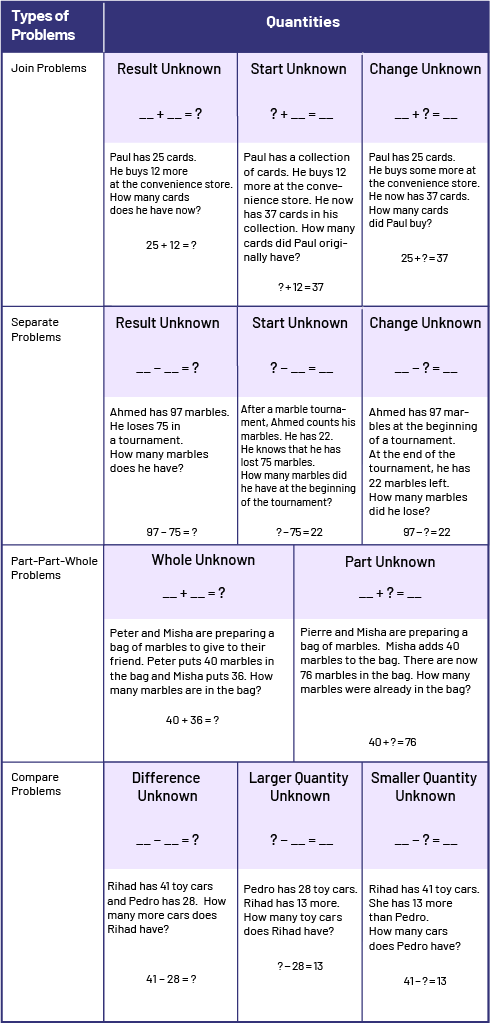
Also known as "Change Problems", joining and separating problems are perceived by students as active situations, easier to model and “see” as the start quantity increases or decreases. Combining or part-part-whole problems, however, assume a static situation, as no action or change occurs, making them more abstract and difficult to understand.
Comparing problems, on the other hand, deal with the relationship between two quantities by contrasting them: so there is no action, but a comparison of one quantity to another to find the difference between them.
Since students are regularly exposed to problems where the result or final quantity is sought, they find these kinds of problems easier to solve. They have more difficulty solving problems where the start quantity or change (joined or separated) is unknown. Therefore, working with these kinds of problems will support the development of a more solid understanding of addition and subtraction and the connections between them. For example, in addition problems where the unknown value is the start quantity, students more easily see the benefits of addition (for example, \(?\; + \;12\; = \;37 \)), which makes it possible to respect the order in which the action takes place in the problem. This allows students to use a strategy (for example, counting or counting down) to determine the start quantity. Here, students demonstrate their understanding of the problem and their ability to use a strategy to solve it. However, they do not demonstrate an understanding of the meaning of difference (and subtraction). If they had used subtraction, that is \(37\; - \;12\; = \;?\), they would have demonstrated a broader understanding of the relationships between these operations. When students are learning, there is no need to impose a strategy on them. The obligation to subtract will not help students who do not see the relevance of this strategy. However, if they regularly experience a variety of problems and participate in the mathematical discussions that follow, they can begin to see the connections between various strategies and will eventually adopt new ones. They then become more efficient.
Source: translated from Guide d’enseignement efficace des mathématiques de la 4e à la 6e année, Numération et sens du nombre, Fascicule 1, Nombres naturels, p 81-84.
Multiplication and Division
To understand multiplication and division, one must recognize the three types of quantities involved: the total quantity (for example, 8 flowers), the number of equal groups (for example, 4 pots), and the size of each group (for example, 2 flowers per pot).

In problems presented to students, division is too often associated with only one type, namely equal-sharing (partitive division). Equal-grouping (quotative division) is usually neglected. With partitive division, the total quantity and the number of groups are known (for example, 3 students want to share 15 apples equally and we look for the number of apples each will receive).
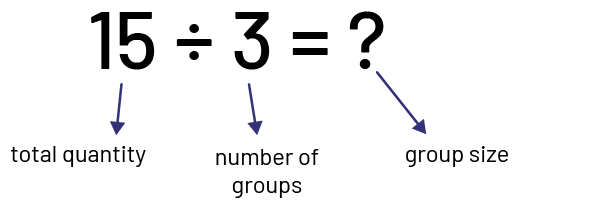
With quotative division the total quantity and the size of the groups are known (for example, we have 15 apples and we want to put them in bags, 3 apples per bag; we look for the number of bags we need).
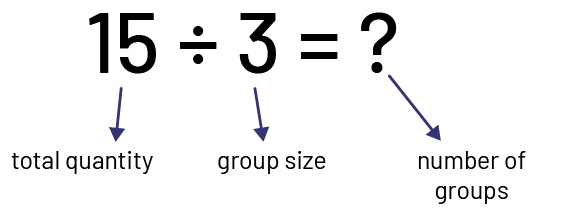
It is essential that students have experience with both types of division problems, as they will develop a deeper understanding of the operation, which is foundational to many other mathematical concepts. It is not necessary for students to know the names of the problem types, but it is essential that they have the opportunity to solve a variety of problem types while using a variety of strategies.
Types of Problems Related to Multiplication and Division

Source: translated from Guide d’enseignement efficace des mathématiques de la 4e à la
6e année, Numération et sens du nombre, Fascicule 1, Nombres naturels, p 84-85.
Effect of Operations
Each operation has an effect on the quantities involved. Depending on the operation, certain quantities increase or decrease. They may increase or decrease by a lot or a little. Tracking the effect of operations on numbers allows students to make connections between operations and to anticipate the result of an operation. For example, if we subtract 8 from 160, we will notice little effect because the difference between 160 and 152 is relatively small. However, if we divide 160 by 8, the effect is large, because the resulting quotient, 20, is much smaller than 160. We can also compare the effect produced by addition to that produced by multiplication. Compared to multiplication, addition increases a number by a small amount. For example, when 160 is multiplied by 8, you get 1280, whereas if you add 8, you get 168. People with good operations sense recognize the effect of operations on whole numbers, but students who are still learning are often impressed by the effect of, for example, multiplication. One caveat is that care must be taken when generalizing, as operations on decimal numbers or fractions may have different effects than those on whole numbers. In some cases, the effect may even be the opposite. For example, if you multiply one whole number by another whole number, the product is larger than both factors (such as 3 by 6, the product 18 is larger than both 6 and 3), whereas if you multiply a proper fraction by a whole number, the product is smaller than either factor. For example, if you multiply \(\frac{1}{2}\) by 6, the product 3 is smaller than 6.
Source: translated from Guide d’enseignement efficace des mathématiques de la 4e à la 6e année, Numération et sens du nombre, Fascicule 1, Nombres naturels, p 90-91.
Skill: Solving Problems Requiring Multiple Operations
Whether it is a problem with one operation or multiple operations, students must make decisions and choices based on the context. A problem-solving approach will introduce them to this thinking. When faced with a problem, they must first analyze it to determine the data and understand that a calculation must be performed. Then, depending on the context, one must know whether one is looking for an approximate or an exact answer. In both cases, depending on the context and the numbers involved, it is then necessary to determine whether the calculation will be performed mentally, in writing or using a calculator. Finally, the desired calculation is performed.
Diagram of the Students' Thinking About a Problem
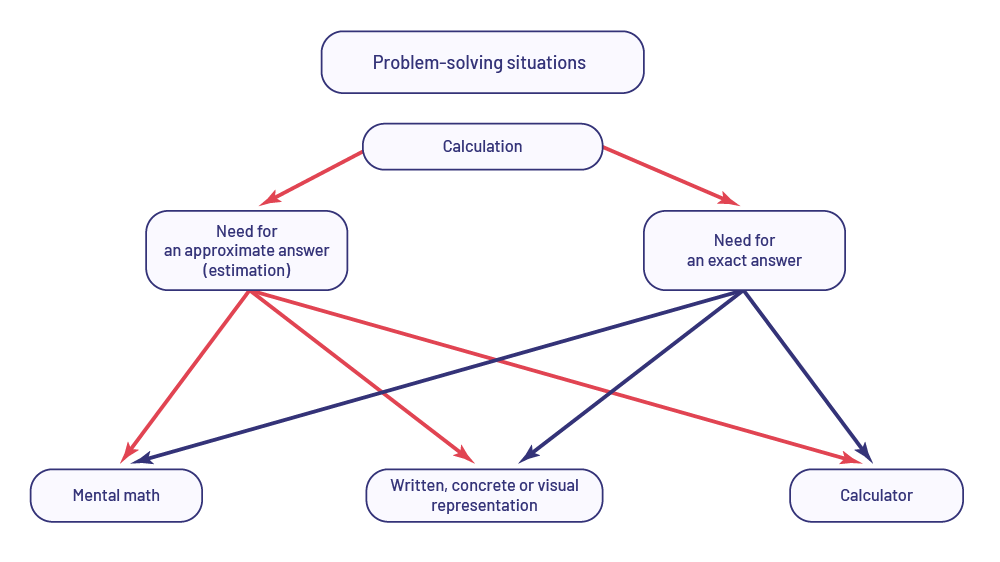
Source: translated from Guide d’enseignement efficace des mathématiques de la 4e à la
6e année, Numération et sens du nombre, Fascicule 1, Nombres naturels, p. 117.
Knowledge: Properties of Operations
A property of an operation is a characteristic that is specific to the operation, regardless of the numbers involved.
The properties of the operations are:
- Commutative Property: \(\left( {3\; + \;5\; = \;5\; + \;3} \right)\);
- Associative Property: \(\left( {2\; + \;9)\; + \;11\; = \;2\; + \;(9\; + \;11} \right)\);
- Distributive Property: \(8\; \times \;7\; = \;\left( {8\; \times \;5} \right)\; + \;\left( {8\; \times \;2} \right)\);
- Identity Principle: \(13\; + \;0\; = \;13\), \(0\; + \;13\; = \;13\); \(25\; \times \;1\; = \;25\), \(1\; \times \;25\; = \;25\); \(25\; \div \;1\; = \;25\);
- Zero Property: \(8\; \times \;0\; = \;0\); \(0\; \times \;8\; = \;0\).
Source: translated from Guide d’enseignement efficace des mathématiques de la 4e à la 6e année, Numération et sens du nombre, Fascicule 1, Nombres naturels, p. 102.
Knowledge: Commutative Property
An operation is commutative if its result remains unchanged when the order of its terms or factors is reversed. Addition and multiplication are commutative. For example, \(27\; + \;63\; = \;63\; + \;27\) and \(8\; \times \;6\; = \;6\; \times \;8\).
Generalization: \(a\; + \;b\; = \;b\; + \;a \quad \text{and} \quad \;a\; \times \;b\; = \;b\; \times \;a\)
Knowledge: Associative Property
The associative property is a property of addition and multiplication. It allows the terms of an expression to be combined in different ways without changing their value.
Generalization: \(\left( {a\; + \;b} \;\right)\; + \;c\; = \;a\; + \;\left( {b\; + \;c}\; \right)\); \(\left( {a\; \times \;b} \;\right)\; \times \;c\; = \;a\; \times \;\left( {b\; \times \;c} \right)\)
Knowledge: Distributive Property
Multiplication is distributive over addition and subtraction.
The distributive property allows one to perform an operation on a sum or a difference of terms and obtain the same result as if the operation had been performed on each term. For example,
- we can multiply \(3\; \times \;\left( {5\; + \;6} \right)\) and arrive at the same result as if we had performed \(\left( {3\; \times \;5} \right)\; + \;\left( {3\; \times \;6} \right)\);
- we can multiply \(3\; \times \;\left( {20\; - \;2} \right)\) by performing \(\left( {3\; \times \;20} \right)\ ;-\;\left( {3\; \times \;2} \right)\).
Generalization: \(a\; \times \;\left( {b\; + \;c\;} \right)\; = \;\left( {a\; \times \;b\;} \right)\; + \; \left( {a\; \times \;c\;} \right)\)
Knowledge: Zero Property
In a multiplication, a factor of 0 has the effect of “absorbing” the other factor, because it means that there are either zero groups, or that the size of the groups is zero and therefore have zero items. So no matter how many are multiplied by 0, the product will always be 0 (for example, \(684\; \times \;0\; = \;0\); \(16.67\; \times \;0 \; = \;0\); \(\frac{1}{4}\; \times \;0\; = \;0\)) and if 0 is multiplied by another number, the product will also be 0 (for example, \(0\; \times \;684\; = \;0\); \(0\; \times \;16.67\; = \;0\); \(0\; \ times \;\frac{1}{4}\; = \;0\)). The number zero is then qualified as an absorbing element for the multiplication.
Generalization: \(a\; \times \;0\; = \;0\), \(0\; \times \;a\; = 0\)
Knowledge: Identity Principle
The Identity Principle of Addition states that when adding 0 to any amount, the amount stays the same (for example, \(287\; + \;0\; = \;287;\; 4.5\; + \;0\; = \;4.5\)). The Identity Principle of Multiplication states that when multiplying an amount by 1 or dividing an amount by 1, the amount stays the same (for example, \(133 \times 1 =133;\; 432.1\; \times \;1\; = 432.1\)). The Identity Principle does not apply in the same way for subtraction and division. In a subtraction, the number 0 has no effect when it is the second term (for example, \(3\; - \;0\; = \;0\)), but it does not if it appears as first term (for example, \(0\; - \;3\; \ne \;3\)). Similarly, in a division, the number 1 produces no effect when it is the divisor (for example, \(3\; \div \;1\; = \;3\)), but it is not the case if it appears as a dividend (for example, \(1\; \div \;3\; \ne \;3\)).
Generalization: \(a\; + \;0\; = \;a\), \(a\; - \;0\; = \;a\), \(a\; \times \;1\; = \;a\), \(a\; \div \;1\; = \;a\)
Source: translated from Guide d’enseignement efficace des mathématiques de la 4e à la 6e année, Numération et sens du nombre, Fascicule 1, Nombres naturels, p 102-107.
Knowledge: Relationships Between Addition, Subtraction, Multiplication and Division
Operation sense involves the ability to represent situations with symbols and numbers. Understanding the meaning of the operations, and the relationships between and amongst them, enables one to choose the operation that most closely represents a situation and most efficiently solves the problem given the tools at hand.
- Addition and subtraction are inverse operations.
- Multiplication and division are inverse operations.
- Multiplication can be associated with repeated addition.
- Division can be associated with repeated subtraction.
Source: Ontario Curriculum, Mathematics Curriculum, Grades 1-8, 2020, Ministère de l’Éducation de l’Ontario.
